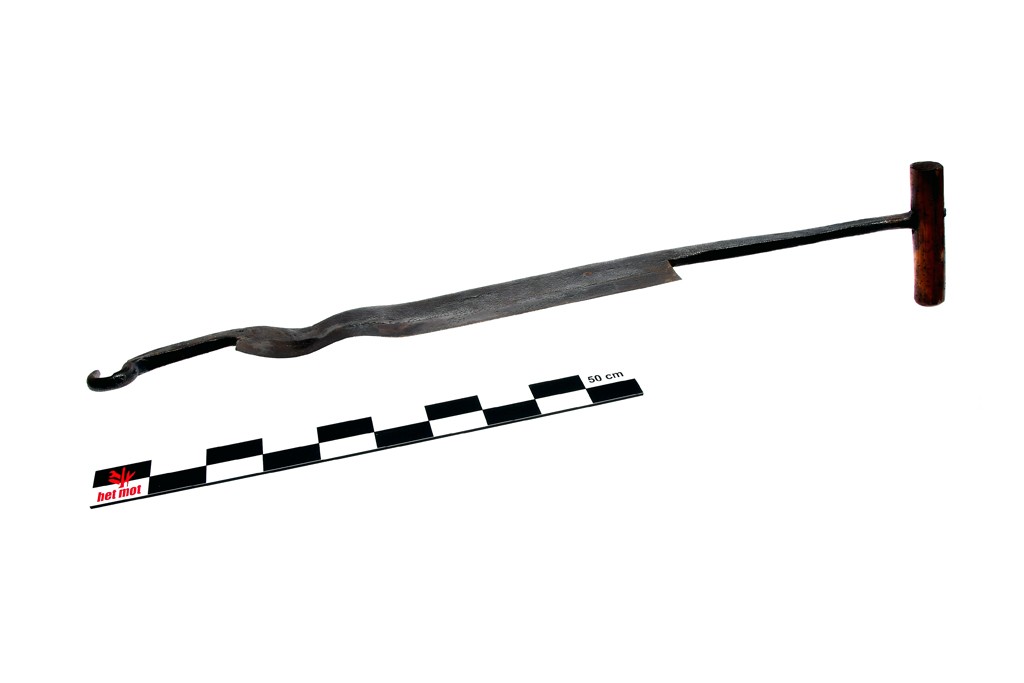ID-DOC: general search
Here you can enter a general keyword and perform a general search.
??? What are these question marks doing here? These represent tools which we know by a Dutch or French name, but who's English name is yet unknown. Suggestions are always welcome!
If you cannot find a certain tool, or if you experience other problems with this page, please let us know at info@mot.be.
Search for: tool
Showing search results 351 - 400
1,422 results found

Cleaving iron, froe
The cleaving iron or froe is used to split laths and staves. When the trunk
is sawn into pieces, the craftsman splits a piece into four or eight with a
splitting wedge or with a splitting wedge with handle. Depending on the
thickness of the triangular cross-section pieces obtained and the type of
laths, these pieces are first divided into two or four with a straight froe
or with a hollow froe. To do this, they are clamped in a wooden frame (1).
The blade is placed on the cross-section and beaten with a wooden
froe-maul. The stem is then pulled down so that the gap widens and the tool
can be pushed into it. Then those pieces are split further with a straight
froe that is usually less thick and sharper than the first. It is handled
in the same way, but the craftsman usually does not use a hammer to drive
the tool into the wood. When the lath gets too thick or too thin, he pulls
or pushes the stem down or up to cut into the wood. The laths can be split
quarter-hourly or flat, i.e. radially...

Cleaving knife
The cleaving knife is an all-metal hand tool for splitting short standing
logs. It is a rectangular iron (20-50 / 5-10 / 0.5-1.5 cm) of which one
long side is sharp and the other is extended by a co-plane rod (approx.
10-15 cm) which serves as a handle. The craftsman, eg the clog maker or the
cooper, places the tool on the cross-section of the piece to be split and
hits it with a froe-maul. The splitting wedge is mainly used for splitting
long horizontal pieces, unlike the cleaving knife and the splitting wedge
with handle. [MOT]

Clinch cutter
The text on the clinch cutter of a shoeing smith can only be consulted in
Dutch. [MOT]

Clinch groover
Clinch groover of a shoeing smith

Clinker tongs
This text can only be consulted in Dutch
<https://www.mot.be/resource/Tool/clinker-tongs?lang=nl>

Clippers
The hairdresser uses these clippers to thin or trim hair. The clippers
combine the comb and the razor knife in one instrument. The handle is
elongated (approx. 13 cm) and is made of wood, iron, aluminum or plastic.
The razor blade is clamped in a holder consisting of two metal plates, at
least one of which is comb-shaped. Handle and holder consist of a whole or
are assembled. Sometimes the holder hinges open or is unscrewed so that a
replaceable razor blade can be clamped in. In another model, the holder is
square and completely made of plastic. In that case, two razor blades are
clamped in the holder on either side. See also clippers for horses, dog
dresser's knife and thinning scissors. [MOT]

Clippers for horses
This text can only be consulted in Dutch
<https://www.mot.be/resource/Tool/clippers-for-horses?lang=nl>

Clog maker's adze
This text can only be consulted in Dutch
<https://www.mot.be/resource/Tool/clog-makers-adze?lang=nl>

Clog maker's axe
The description of the axe of a clog maker is available in Dutch.

Clog maker's drill
This text can only be consulted in Dutch
<https://www.mot.be/resource/Tool/clog-makers-drill?lang=nl>

Clog maker's gouge
This text can only be consulted in Dutch
<https://www.mot.be/resource/Tool/clog-makers-gouge?lang=nl>

Clog maker's heel knife
This text can only be consulted in Dutch
<https://www.mot.be/resource/Tool/clog-makers-heel-knife?lang=nl>

Clog maker's mallet
The clog maker's hammer is a heavy, round wooden hammer with a short
handle. It is used to hit the clog maker's gouge and thus roughly cut out
the interior of the clog. [MOT]

Clog maker's sole knife
This text can only be consulted in Dutch
<https://www.mot.be/resource/Tool/clog-makers-sole-knife?lang=nl>

Clog maker's timber scribe
Hand tool that is very similar to the timber scribe and the beam scribe and
is used by the clog maker to decorate the clogs. See also hoof cleaning
knife. [MOT]

Clog maker's toe knife
This text can only be consulted in Dutch
<https://www.mot.be/resource/Tool/clog-makers-toe-knife?lang=nl>

Clogger's gripper
This text can only be consulted in Dutch
<https://www.mot.be/resource/Tool/cloggers-gripper?lang=nl>

Clogger's hollowing knife
This text can only be consulted in Dutch
<https://www.mot.be/resource/Tool/cloggers-hollowing-knife?lang=nl>

Clogger's paring knife
This text can only be consulted in Dutch
<https://www.mot.be/resource/Tool/cloggers-paring-knife?lang=nl>

Closer's hammer
Full metal shoemaker's tool (min. 13 cm long) with a swollen, cylindrical
center piece; one end is circular, the other wedge-shaped. The middle part
acts as a handle. The rapping hammer is used to smooth seams, by tapping
one end and rubbing with the other, and to smooth wrinkles on the last. See
also the seam rubber. [MOT]

Closer's welt plough
This text can only be consulted in Dutch
<https://www.mot.be/resource/Tool/closers-welt-plough?lang=nl>

Clothes beater
In order not to wear out the clothes by daily brushing, the dust can be
knocked out. This was done with a wicker clothes beater (1), comparable to
the carpet beater, or a kind of whip with mostly leather straps, which also
served to knock out cushions. See also the clothes brush. [MOT] (1)
Translation of the dutch word 'kleerklopper'. The proper name in english is
yet unknown.

Clothes brush
The clothes brush is a brush that can be used to brush dust, fluff, etc.
from clothes. It has short (approx. 2 cm), strong hair that is flexible
enough not to damage clothes when brushing. See also the clothes beater.
[MOT]

Club hammer
Heavy metal hammer (up to 15 kg) with long handle (up to approx. 80 cm)
suitable for various purposes. This tool is used by many craftsmen, the
quarry worker uses it to drive wedges into the rock. It can be
distinguished from the mash hammer which is lighter and has a shorter
handle. [MOT]

Coal scoop
Metal shovel with a flat or concave elongated blade (approx. 10-15 cm wide;
approx. 20-25 cm long) with raised edges for scooping small amounts of coal
into the stove. It can be made entirely of metal or have a metal blade
attached to a wooden handle. It is often decorated and combined with the
coal bin. See also coal scoop (brick maker) and charging shovel. [MOT]

Coal scoop (brickmaker)
During the firing of bricks in a ring kiln, small amounts of coal are added
from above (see also coal funnel). This is done with a semi-cylindrical
coal shovel.. See also coal scoop and coal shovel. [MOT]

Coal shovel
Shovel with broad blade and sloping edges, fitted with a wooden D-handle.
The coal shovel is used by the coal merchant for shoveling coal. See also
the charging shovel. [MOT]

Cobweb brush
Brush - sometimes made of goat hair - in the shape of a sphere or
hemisphere or around a triangular bracket, attached to a long wooden or
plastic handle that is often extendable (up to approx. 3 m) and is used to
remove spider silk. [MOT]

Coffee mill
Roasted coffee beans can be finely ground with a coffee mill. It has
grooved, cast iron grinding discs, which are set in motion by means of a
rotating crank. The grinding mechanism of most coffee mills can be adjusted
from coarse to fine with an adjusting screw. The coffee mill can have a
square wooden housing with a rotating crank at the top and a drawer at the
bottom where the ground coffee ends up (approx. 10-15 cm wide; approx.
20-26 cm high). The housing can also be cylindrical (approx. 8-10 cm in
diameter; approx. 10-20 cm high) and made of metal. Another model is made
of cast iron (approx. 12-27 cm wide; approx. 30-45 cm high) and is screwed
to the edge of the table or counter. At the top there is a funnel where the
coffee beans are placed; under the grinder there is a receptacle or a
spout. In the latter case, a separate container must be placed underneath.
The crank is located alongside. There is also a wall model. The painter
uses a similar tool to grind pigments. [MOT]

Cold Chisel
This text can only be consulted in Dutch
<https://www.mot.be/resource/Tool/cold-chisel?lang=nl>

Collar joint flaring tool
This text can only be consulted in Dutch
<https://www.mot.be/resource/Tool/collar-joint-flaring-tool?lang=nl>

Combination pliers
This text can only be consulted in Dutch
<https://www.mot.be/resource/Tool/combination-pliers?lang=nl>

Comedo extractor
This text can only be consulted in Dutch
<https://www.mot.be/resource/Tool/comedo-extractor?lang=nl>

Commander (basket maker)
For more technical information on this hand tool of a basket maker, you can
visit the dutch version of this page. [MOT]

Communion wafel iron
This text can only be consulted in Dutch
<https://www.mot.be/resource/Tool/609?lang=nl>

Compass
This text can only be consulted in Dutch
<https://www.mot.be/resource/Tool/compass?lang=nl>

Compass race
This text can only be consulted in Dutch
<https://www.mot.be/resource/Tool/compass-race?lang=nl>

Compass saw
The compass saw is used to cut curved lines and especially to cut a hole in
the center of a shelf. It resembles the handsaw but is shorter (approx.
20-30 cm) and has a much narrower blade (approx. 1.5-2 cm) that tapers to a
point and is fixed in an open pistol grip or a straight handle. There are
now small compass saws with straight metal handle in which the blade
slides, so that the artisan can have the latter protrude just as much as
necessary. The joiner drills a hole in the shelf and inserts the end of the
saw into it. Despite the lack of rigidity, this saw usually works when
pushing.The drill saw is used to perform the same operations with one hand
tool. [MOT]

Concave plane
This text can only be consulted in Dutch
<https://www.mot.be/resource/Tool/concave-plane?lang=nl>

Concreter's nippers
This text can only be consulted in Dutch
<https://www.mot.be/resource/Tool/concreter-s-nippers?lang=nl>

Cone spanner
This text can only be consulted in Dutch
<https://www.mot.be/resource/Tool/cone-spanner?lang=nl>

Confectionary brush
This text can only be consulted in Dutch
<https://www.mot.be/resource/Tool/1203?lang=nl>

Cookie cutter
This text can only be consulted in Dutch
<https://www.mot.be/resource/Tool/cookie-cutter?lang=nl>

Cooper's bottom chamfering plane
This text can only be consulted in Dutch
<https://www.mot.be/resource/Tool/coopers-bottom-chamfering-plane?lang=nl>

Cooper's bow compass
This text can only be consulted in Dutch
<https://www.mot.be/resource/Tool/coopers-bow-compass?lang=nl>

Cooper's bung-borer
This text can only be consulted in Dutch
<https://www.mot.be/resource/Tool/coopers-bung-borer?lang=nl>

Cooper's chamfering drawing knife
This text can only be consulted in Dutch
<https://www.mot.be/resource/Tool/coopers-chamfering-drawing-knife?lang=nl>

Cooper's chiv
This text can only be consulted in Dutch
<https://www.mot.be/resource/Tool/coopers-chiv?lang=nl>

Cooper's handle-scraper
Primarily a painter's tool, the handle-scraper is sometimes used to scrape
wood smooth, to clean the interior of a barrel, to finish pottery products,
etc. It is usually a triangular metal plate (5-14 cm) with a metal rod in
the middle of the surface that sticks into a wooden handle. One of the
sides can be arcuate. The tool differs from the cooper's inshave drawing
knife in that the direction of the blade and that of the machined part are
perpendicular to each other. See also the box scraper, the putty scraper
for glass and the foam scraper. [MOT]

Cooper's heading drawing knife
This text can only be consulted in Dutch
<https://www.mot.be/resource/Tool/coopers-heading-drawing-knife?lang=nl>
